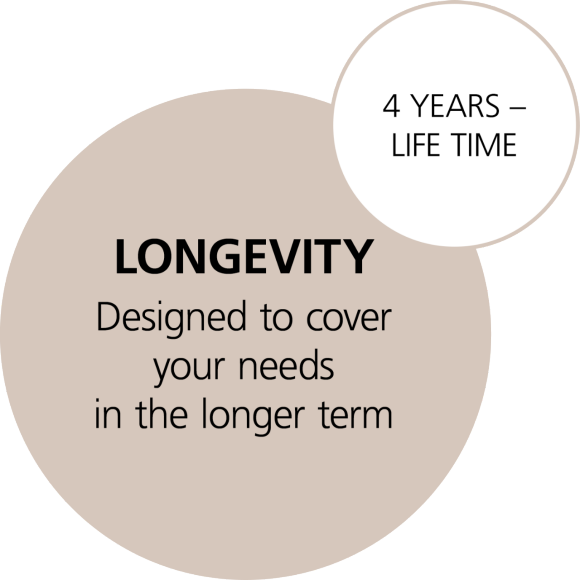Assets
Wealth planning: prepare for the future
What are your life goals? What will you pass on to your family and the wider world? These considerations will help you plan ahead.

![]()
header.search.error
Assets
What are your life goals? What will you pass on to your family and the wider world? These considerations will help you plan ahead.

What are your ambitions? Who and what really matter to you? What do you want to achieve for yourself and your family? And how do you want to plan your inheritance? When it comes to your aims and needs, the financial aspects must always be taken into account too. But we are often all too happy to put off dealing with them until later. Discussing your inheritance with your heirs is a particularly sensitive issue, whereby various aspects have to be taken into account.
When planning your finances, it is crucial to factor in all aspects as they relate to your short-, medium- and long-term goals. The UBS Wealth Way approach provides this holistic approach. It gives you a clear overview of your wealth and resources, helping you to allocate and manage them according to your individual needs. It takes into account, for example, that women tend to take a more cautious approach to investing and have different pension needs due to their longer life expectancy.
Holistic wealth planning – for when you’re no longer here
UBS Wealth Way is an advisory approach that factors in the three key strategies Liquidity, Longevity, Legacy, taking into consideration your plans and goals – be they short-, medium- or long-term – across different time horizons. Some goals are quite natural, such as renovating a house or paying for your children’s education. Others, such as making sure that your wealth is passed on and actually received in accordance with your wishes, may be less so.
More specifically, the strategies Liquidity, Longevity, Legacy cover the following time horizons:



Your financial aims and those of your partner or successors form the basis of your wealth planning. It takes conscious decision-making to establish and regularly review a set of goals. Think about what your desired lifestyle would look like and how you can improve the lives of others.
Determine your plans for the years to come
What expenses will you have to pay in the next three years? Are you planning a trip? Perhaps you want to buy a home? A good Liquidity strategy is key to meeting your current expenses in years to come. It includes the assets needed to cover your short-term annual expenses, as well as a safety cushion for greater peace of mind.
Getting this strategy right depends on two specific factors. First of all: how much of your current expenses are covered by your current income. Second: how much risk you are willing and able to take with your investment portfolio as part of your wealth planning. The riskier the investments in your long-term portfolio, the more liquid it needs to be. You will then be prepared for market fluctuations and will not need to sell any investments if they are currently not doing so well.
The more your expenses exceed your income, the more liquidity you will need. Once you are retired, you can calculate this liquidity based on your pension plus a multiple of one to three times your annual expenses or one to three times your excess spending. This will give you a range by which to determine how much liquidity you will need.
Long-term planning: how to maintain your lifestyle in retirement
Long-term planning, or the Longevity strategy, is about financing everything that will allow you to maintain your lifestyle, as well as anything beyond that. This might include your retirement or a second home.
Ensuring you have enough money in retirement is especially important for women, as they live longer than men, but typically earn less.
Your investment portfolio can be transitioned over time. It can also be used to consolidate your Liquidity strategy after a period of high spending, or to supplement your Legacy strategy if you spend less than expected. If your Liquidity and Longevity strategies are well-coordinated, you can achieve long-term goals even in the event of economic crises or market fluctuations.
After you’re gone – planning for the needs of others
The Legacy strategy includes any assets that you don’t need to achieve your own aims. This can be wealth which you pass on to future generations or philanthropic projects and other good causes that you care about.
Honest and open communication with your family, a carefully considered succession plan and an appropriate investment strategy are key to successfully passing on your wealth. Find out more in our article “Transmission of assets: make plans early on”.
Draw up a plan for your wealth
Regardless of your gender, it is critical that you address your short-, medium- and long-term goals and wishes strategically. The holistic UBS Wealth Way approach enables you to address your individual needs in the best way possible.
The first step is to talk to others about it – be it with your partner, a friend or a UBS client advisor.
Would you like to learn more about UBS Wealth Way? You can also read our overview “UBS Wealth Way”.

Expand your financial knowledge
Would you like to learn more about “assets”? Then subscribe to our “Assets” learning path today.
Because a personal conversation is worth a lot
What can we do for you? We’re happy to address your concerns directly. You can contact us in the following ways: